 |
 |
 |
| |
A multi-compartment single and multiple dose pharmacokinetic comparison of rectally applied tenofovir 1% gel and oral tenofovir disoproxil fumarate
|
| |
| |
Reported by Jules Levin
15th International Workshop on Clinical Pharmacology of HIV & Hepatitis Therapy, Wash DC, 2014 May 19-21
K.H. Yang1, C. Hendrix2, N. Bumpus2, J. Elliott3, K. Tanner4, C. Mauck5, R. Cranston6, I. McGowan6, N. Richardson-Harman7, P.A. Anton3, A.D.M. Kashuba1
1UNC Eshelman School of Pharmacy, DPET, Chapel Hill, USA; 2Johns Hopkins University School of Medicine, Medicine and Pharmacology, Baltimore, USA; 3UCLA School of Medicine, Center for HIV Prevention Research AIDS Institute, Los Angeles, USA 4UCLA School of Public Health, Biostatistics, Los Angeles, USA; 5CONRAD, n/a, Arlington, USA; 6University of Pittsburgh, Medicine, Pittsburgh, USA; 7Alpha StatConsult LLC, n/a, Damascus, USA
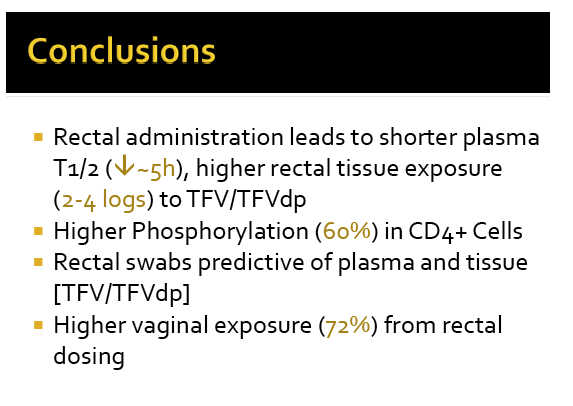
Abstract:
Introduction
Both topical and oral tenofovir (TFV)-containing regimens have demonstrated efficacy in HIV prevention. The primary objective of the Phase 1 RMP-02/MTN-006 clinical trial was to evaluate the systemic safety of TFV 1% gel when applied rectally. Built into this study was a comprehensive pharmacokinetic evaluation comparing systemic and compartmental pharmacokinetics among oral TDF and rectal TFV 1% gel users. This is the first study to quantify human rectal mucosal pharmacokinetics after topical administration of tenofovir in multiple compartments concurrently, to compare it to exposure after oral administration and to determine whether less-invasive indicators of tenofovir diphosphate (TVFdp) concentrations in tissue CD4+ cells emerge, potentially playing a future role in large clinical trials.
Material & Methods
This Phase 1, randomized, two-site (United States), double-blind, placebo-controlled study enrolled 18 sexually abstinent men and women. All received a single 300-mg dose of oral tenofovir disoproxil fumarate (TDF) and were then randomized 2:1 to receive single and then seven daily rectal exposures of vaginally-formulated TFV 1% gel or a hydroxyethyl cellulose (HEC) placebo gel. Blood, colonic biopsies and rectal and vaginal mucosal fluids were collected after the single oral TDF, the single topical TFV gel dose, and after 7 days of topical TFV gel dosing for extracellular analysis of TFV and intracellular analysis of the active metabolite TFVdp in peripheral blood mononuclear cells (PBMCs) and isolated mucosal mononuclear cells (MMC), including CD4+ and CD4- cell subsets.
Results
With a single rectal dose, TFV plasma concentrations were 24-33 fold lower and half-life was 5h shorter compared to a single oral dose (p=0.02). TFVdp concentrations were also undetectable in PBMCs with rectal dosing. Rectal tissue exposure to both TFV and TFVdp was 2 to 4-log 10 higher after a single rectal dose compared to a single oral dose, and after 7 daily doses, TFVdp accumulated 4.5 fold in tissue. TFVdp in rectal tissue homogenate was predictive (residual standard error, RSE=0.47) of tissue MMC intracellular TFVdp concentration, with the CD4+ cells having a 2-fold higher TFVdp concentration than CD4- cells. TFV concentrations from rectal sponges was a modest surrogate indicator for both rectal tissue TFV and TFVdp (RSE=0.67, 0.66, respectively) and plasma TFV (RSE=0.38). TFV penetrates into the vaginal cavity after oral and rectal dosing, with rectal dosing leading to higher vaginal TFV and TFVdp concentrations (p<0.001).
Conclusions
The compartments included rectal fluid, rectal tissue and its isolated mucosal mononuclear cells, vaginal fluid, blood plasma and PBMCs. It was expected, and now confirmed, that rectally applied TFV would have lower systemic exposure and higher vaginal exposure compared to oral. There was accumulation of TFVdp in the rectal tissue, due to the long intracellular half-life. An unexpected yet biologically interesting finding was detecting a consistent difference in concentrations of TFVdp in rectal mucosal CD4+ cells, prime targets for new HIV infections. It is useful to know that TFV rectal fluid concentrations may be reasonable bio-indicators of plasma and, importantly, rectal tissue concentrations, making it easier to estimate adherence and TFV concentrations in the target tissue.

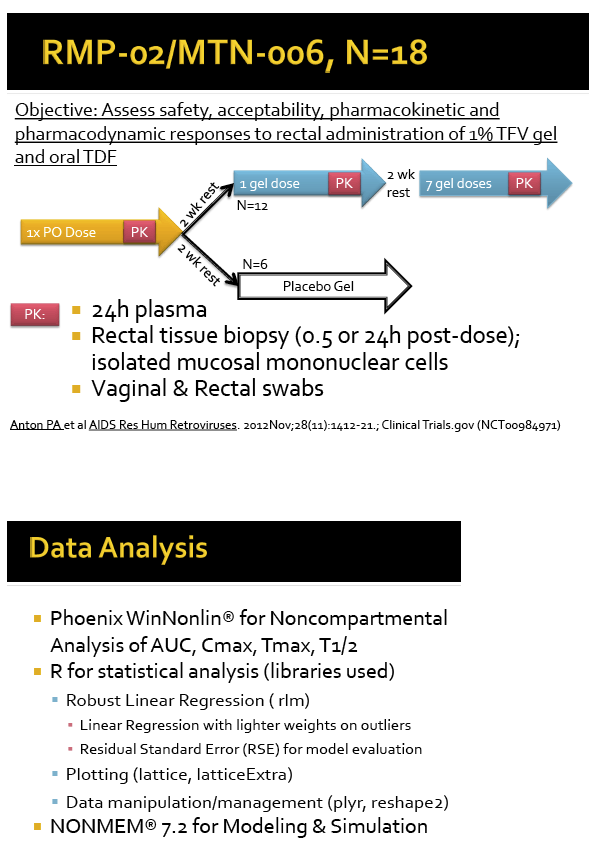
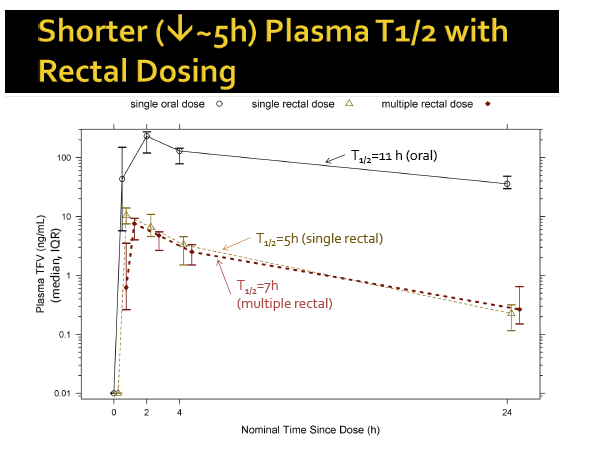
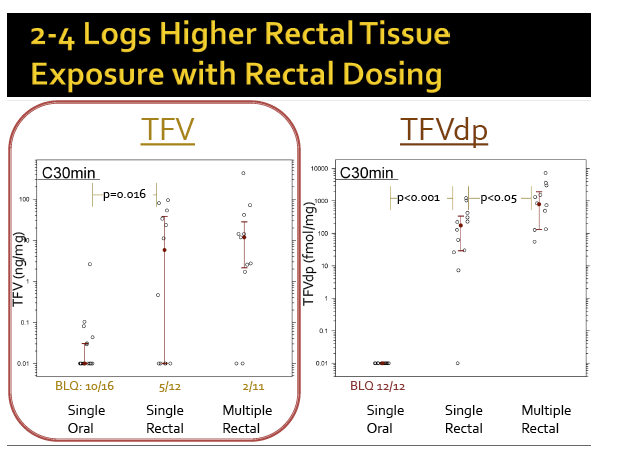
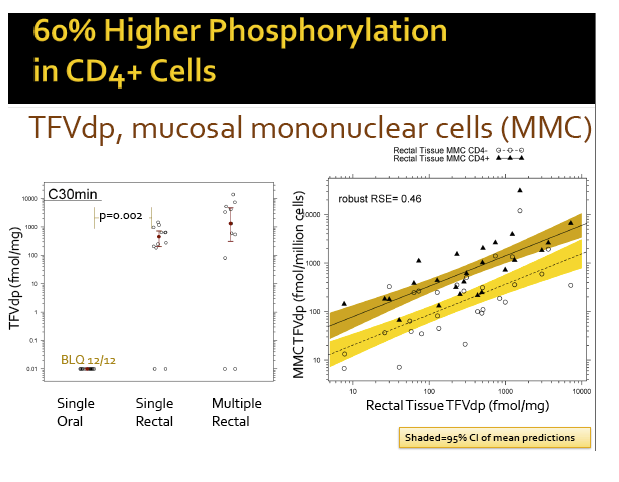
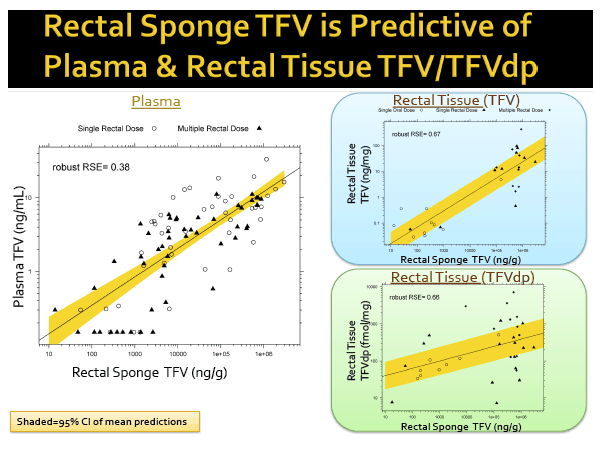

|
| |
|
 |
 |
|
|